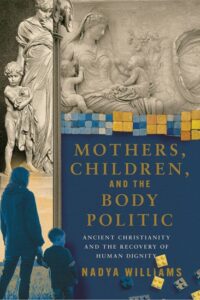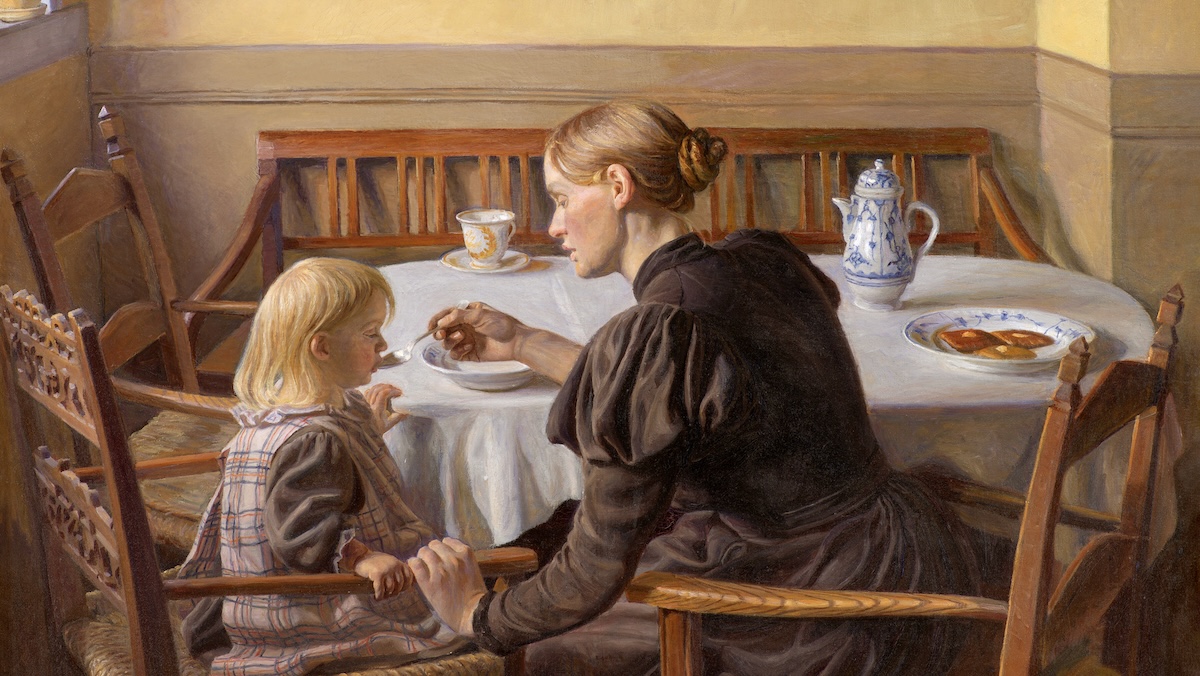As Anastasia Berg and Rachel Wiseman demonstrate in their thought-provoking 2024 book, What Are Children For? On Ambivalence and Choice, decisions about childbearing are now considered morally neutral, flowing only from one’s self-understanding and individual desires. The regnant feminist perspective holds that any preference for more marriages and more children is traditionalist judgementalism. It asks us to politely ignore, even in our own minds, the moral fact that each human life is a blessing. It also requires that we reject the societal fact that those with more children are those making greater investments in everyone’s future. Whether a woman has one child or two, ten children or zero, is supposed to be a question of personal preference alone.
These presumptions foreground a Beauvoirian notion of individual identity (which motherhood threatens) as the be-all, end-all of women’s liberation. This is the progressive feminist milieu, in which the virtue of chasing a sexually liberated, professionally empowered ideal is not up for debate. This pursuit of oxymoronic, sexualized androgyny is the air most of us breathe. They call it “girl power.” Everything is awash in it, from Disney movies to the typical English class.
Yet it is becoming increasingly clear that this near-universal valorization of professionally ambitious promiscuity is not reflective of what most women truly want. As Louise Perry argued in The Case Against the Sexual Revolution (2022), girls’ well-documented discomfort with hook-up culture is inextricable from today’s notion of women’s sexual pseudo-empowerment. Moreover, modern feminists’ failure to acknowledge the well-established desire of most women to spend more time mothering and less time working involves no mystique, but an unwillingness to recognize women’s average differences with men. Declining marriage rates, a fertility crisis, and increasing rates of female anxiety and unhappiness are all perpetuated by a hegemonic bill of goods about women’s desire for a functionally androgynous identity.
The shallowness of the “girlboss” ideal, in which each woman is a disembodied incarnation of a self-expression that may or may not include motherhood of a child or two, understandably repels many thoughtful women. Looking for a framework in which pregnancy and birth are met with unique joy, family life is valued, and women are not expected to be the same as men, some women are drawn to the “tradwife” identity and its pronatalist orientation instead.
But the perils of an identitarian paradigm are very much at work in tradwifery, too. The fetishization of maximal fertility on the right ultimately imperils the futures of exactly the women who are best disposed to take us past today’s mainstream feminist hegemony and toward something better: a future in which more motherhood of more kids is a holistic expression of well-formed, multifaceted, vocational womanhood—not just another cheap identity.
The Perils of Identitarian “Maximal Maternity”
Before I delve into what those perils are and why they matter, let me offer a contextualizing caveat: A woman who has a lot of kids and delights in them is obviously doing nothing wrong and likely doing a lot right. In 2024’s Hannah’s Children: The Women Quietly Defying the Birth Dearth, mother of eight and economist Catherine Pakaluk describes women of large families who see their children as blessings. These are inspirational examples of godly stewardship entirely compatible with and constitutive of the vocational womanhood for which I’m arguing.
Unfortunately, a very different mindset concerning marriage and motherhood has reared its head on parts of the right, in a precise identitarian inversion of mainstream feminist indifference to the traditional family. For mainstream feminists, a woman’s truest self is impeded by maternity. For certain politicized pronatalists, a woman’s truest self is inextricable from and encompassed by maximal maternity. As Helen Roy explains in her recent essay, “Fertility Idolatry,” to this way of thinking, female virtue is expressed only through marriage and motherhood. Hence, the earlier a woman has children and the more children she has, the greater her virtue and her value.
This growing tendency on parts of the right to equate womanhood solely with male sexual fulfillment and/or physical motherhood opens up cultural space for the neo-pagan misogyny that is now rearing its head in an increasingly influential “manosphere.” Exhibit A: The valorization of Andrew Tate and those of his ilk—who abuse and discard women and then brag about it—that is increasingly attractive among right-leaning young men. Exhibit B: The cultural elevation of Elon Musk—who endorses having babies but is indifferent to marital fidelity, having fathered thirteen children with four different women—and the political normalization of Donald Trump—an admitted adulterer who fathered five children with three different women—as “conservative” figures on the side of the political spectrum that supposedly celebrates family values. Exhibit C: The many viral posts on social media proclaiming the value of teen pregnancy and telling twenty-something women to “just get pregnant,” and “go into debt if you have to.”
This sort of “bro” misogyny is dangerous for the women it deplores and delimiting for the man-children it validates. The degradation of women as existing to fulfill unintegrated male desires—or bear children without male commitment—is “toxic masculinity” incarnate. Indeed, it is women’s mistreatment by men—the failure of unvirtuous men to extend to women, and especially to poor women and to the children in women’s care, the protection due a physically more vulnerable person with equal human dignity—that inspired the early women’s movement. As Erika Bachiochi has explained, the legal codification of men’s obligation to comply with the dictates of Christian virtue (i.e., chastity, nonviolence, marital fidelity, etc) in relation to women and children was a central impetus for first-wave feminism.
For many women who are attracted to the “tradwife” lifestyle, the dangers of an increasingly misogynistic online and IRL “manosphere” may seem personally remote. Keturah Hickman, for example, dismisses concerns about “online red-pill bros,” telling us that we should simply “ignore them” because theirs is “uncharitable, unchristian behavior that should not be fed into.” Hickman grew up the oldest of twelve children, values her upbringing, and is now the wife of a virtuous man who cherishes her. The rise of online misogyny on the right doesn’t seem to have anything to do with her.
In the zeal to claim and embody an identity in the ongoing mommy wars, it can be tempting to ignore the mistakes of those on “our side” who we see as misguided or extreme. From my vantage point on the “other side,” as a professionally ambitious woman who came of age in the secular mainstream, I understand this impulse as well as anyone. And I understand why it’s not one we should indulge.
Both the “Girlboss” and the “Tradwife” Archetypes Limit the Lives of Women
American women today want more children than we’re having. Indeed, thirty-something women like me, who came up in the progressive feminist mainstream yet wound up happily married mothers of several children are luckier—and more countercultural—than we should need to be. In my early 20s, I was enrolled in a PhD program about four hours away from my hometown, where my fiancé was in law school and my parents lived. It soon became apparent that my professional ambitions were, given the particulars of my department and my prospective dissertation committee, on an impending collision course with my personal ones. There was not a single female faculty member in my department with more than one child, for example, and to my knowledge no one thought this was a problem. In retrospect, I should have evaluated potential schools with the excesses of mainstream feminism—and the extent to which I could work around them, culturally and geographically—much more front of mind.
Eventually, I recognized that both my ability to complete the degree and my potential trajectory in academia would be stymied by my countercultural plan to get married and start a family sooner rather than later. So, at 24, I left the program with my MA and moved back home. In a lucky break, I immediately gained late admission to a less competitive doctoral program in a less competitive field at a less competitive university. At 28, a year after my first child was born, I earned my degree. Before choosing, at 34, to stay home with my growing family (then three children, now four) and to write, I had a career in higher education with a solid trajectory.
But the fact that things turned out fine for me, both personally and professionally, does not mean that the feminist mainstream in which I lived, with its presumptive valorization of the girlboss identity, is harmless. So many women my age have not been so fortunate. Increasing numbers are unable to find love at all; others contend with waning fertility after later marriage. Things are looking even more troubling for women younger than me. I cannot ignore these struggles just because I escaped them. The girlboss ideal and its unchallenged primacy in mainstream American culture delimits many female lives before they really get started.
The same can be said of tradwifery, indicating that this identity, too, does more harm than good. I recently talked with two young women, sisters ages 22 and 21, who grew up as outliers in the traditionalist Catholic community, much as I did in the mainstream feminist one. Over breakfast, they explained to me how the excesses of pronatalism show up on the ground. Many of the young men they see on the right—and not just on the online right, but in the real life that online culture both reflects and helps to create—are addicted to pornography. They appear to want wives primarily, if not solely, to replace that outlet (and with just as little interference in the rest of their lives as sex-by-screen involves). Many are reliant on their parents for financial security, but rush toward marriage with parental approval nonetheless, adhering to the pseudo-chastity of “waiting until marriage” by not waiting to get married. Many start families before being at all stable, either professionally or personally, believing that children are a proxy for virtue.
Without other socially sanctioned options for a virtuous life, young women too often let these young men off the hook for actually earning their hands in marriage. Meanwhile, my informants told me, these same young women let themselves off the hook for achieving a foothold in any field that could serve their families and communities. Why? Because bearing and raising children has been sold to them as the only worthwhile thing for women to do, the only ambition worth chasing. In the “trad” zeitgeist, it seems, the political is personal—and all-consuming. Of course, this is not actually “trad” at all. Historically, most women both had children and contributed to economic production in direct ways. Moreover, exactly like the zeitgeist on the left, it curtails women’s, and thereby society’s, full flourishing.
The girls I spoke with are beautiful and engaging. They live at home while attending college, and they are smart, studying math and science, respectively. They were homeschooled, are politically conservative, and attend Mass. They will make wonderful wives, mothers, and societal “load-bearing walls”—in part because they have a reality principle that has not been eradicated by the lies of mainstream feminism. And they want to find love with men who are their equals in both intellect and character. But this is easier said than done. Girls more in thrall to the tradwife ideal marry these “red pill bros” at 19 and bear a half-dozen of their children by 29. What makes the young women I talked to outliers among their peers is that they are unwilling to settle for men who fall far short of any reasonable bar for the sacramental vocation of marriage. They are not interested in identifying as tradwives.
The Nuanced Tension of Vocation
The curated girlboss identity is a performance that centers the self. This is also true of the equally curated tradwife identity, in which number of babies is directly related to a women’s worth. The brittleness of these post-modern archetypes belies their fundamental unfitness to encapsulate the vast array of human experience—including female experience, since women are in fact humans.
By contrast, the supple rigor of a vocational mindset, in which one centers God in a specific sacramental and/or societal role—while maintaining the responsibility to discern the precise form that role should take—allows us to recognize that more than one thing is true at the same time.
If more women and men made their foundational decisions in the vocational mindset rather than the identitarian one, there would probably be more early marriages and fewer aspiring girlbosses with one child or no children. But there would also be fewer tradwives eager to post their eight kids on Instagram. Yes, individuals and society would be better off if more people married younger and had larger families. And yes, people who birth fewer children by choice are often (though not always) those who see a child as something one has, when in fact a child is rightly understood as something one gives (and that one is given).
Nevertheless, a particular woman living her vocation as a wife and mother will not necessarily—and should not necessarily—have a large family. As Pakaluk insightfully notes at the beginning of Hannah’s Children, it is entirely possible to mother one child with a vocational orientation. Likewise, as Roy thoughtfully observes in her essay, it is also entirely possible to mother eight children with an identitarian one. Whatever the outcome, when “wanting” and “having” are the relevant considerations, we’re in the realm of identity. By contrast, when “discerning,” “giving,” and “receiving” are the metrics being used, we’re in the realm of vocation.
Perhaps what I am really arguing, in making the case for vocation over identity, is something as banal as not judging a book by its cover. Quantifying female virtue and worth by way of fertility on the right—exactly like quantifying female intelligence and empowerment by way of professional achievement and a decentering of fertility on the left—is a fool’s errand. It fails to take into consideration that individuals have both internal (health, marital, spiritual) and external (familial, financial, societal, professional) strengths, limitations, and callings that are not always readily apparent. It’s easy, after all, to see, judge, and compete with what other women have—personally, professionally, or otherwise. It’s not so easy to see, judge, or compete with what other women give and receive. These factors and ways of giving and receiving can’t be so easily quantified, and they may reasonably militate either for or against the bearing of a(nother) child.
What we should be seeking for ourselves as women, as well as for our sisters, daughters, and friends, is a vocational mindset to discern the truest, most holistic living out of our own particular callings.



